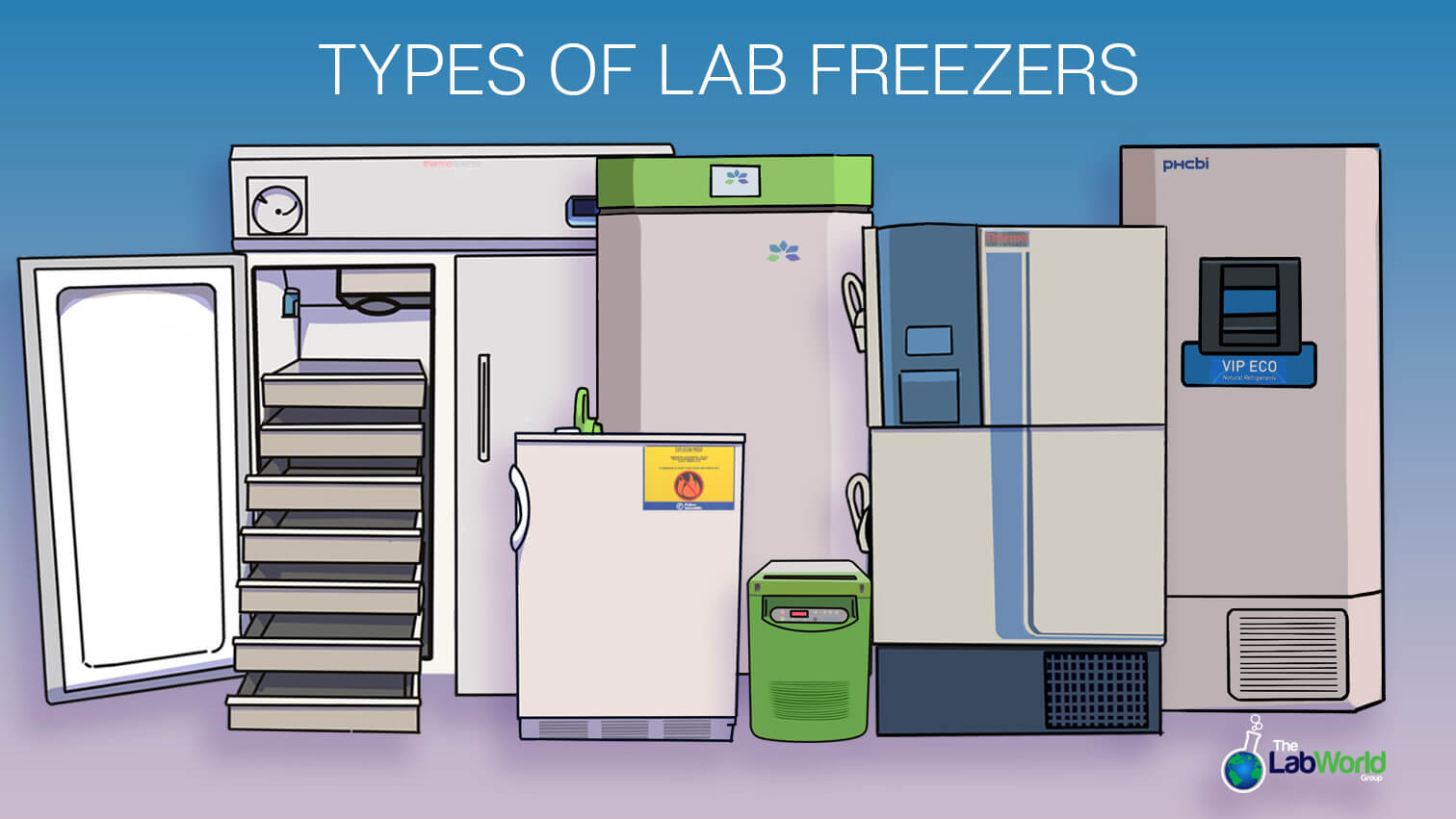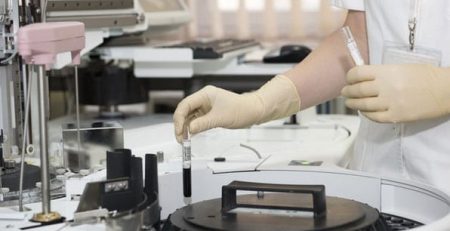
Types of Laboratory Freezers
Amanda2022-05-20T13:27:56+00:00Laboratory freezers and cold chain storage is an integral part of a laboratory. But which freezer is the best for your needs and what that looks like can vary wildly. In this article, we’ll take a look at the many different flavors a laboratory freezer can come in and drill down on what to consider when it’s time to buy.
Lab Freezer Temperature
What you need to store and how cold it has to be is the first step to determining what you’re looking for in this laboratory staple. A general-purpose lab freezer will have a range of temperature between -12 and -25 degrees C. A -20° freezer is ideal for storing everyday items, enzymes, biochemicals, reagents, and samples that don’t need low or ultra-low temperatures. These units tend to have more robust components than our at-home counterparts and can be basic with a mechanical thermostat, or more advanced to include digital monitoring, access ports, glycol insulated temperature probes, or alarm contacts that you just wouldn’t find in a domestic model.
Low-Temperature Freezers run typically from -30 to -40°C and are ideal for biological samples like blood and blood components to prevent spoilage and preserve potency. These Low temp freezers are ideal for items that need to be stored long-term and help slow decay over time.
As demonstrated in the public eye with the COVID vaccine, in some cases even -40°C isn’t cold enough. Ultra-low temperature freezers have a range between -50 and -90 degrees Celcius and represent about as cold as you can get without adding liquid cryogenics. When temperatures are this low, the items inside tend to be high value, and users are deeply invested in keeping them secure.
ULT freezers usually have the most monitoring and security options you can find. These can range from temperature probes and digital reporting and chart recorders for continual monitoring, remote alarm contacts and backup batteries, LN2 backup systems, password protection, and more. Lower temperature freezers also depend on quick access and retrieval of items to keep temperatures relatively level so organization within is key.
Specialty Purpose Freezers
The next thing to consider but just as important as the temperature range, are the requirements of your lab’s environment or the materials you’re working with. Laboratory freezers and refrigerators can be specialized for a particular purpose and to address potential safety issues. Are you working with flammable materials? Does the air in your lab environment run the risk of being explosive? For the times when you need to store items with highly volatile compounds, and vapors safely, flammable and explosion-proof freezers are required. Flammable storage freezers house volatile materials, explosion-proof freezers are used when the atmosphere in a lab itself is a risk
Explosion-proof lab freezers are built to meet strict specifications set by safety agencies like the National Fire Protection Agency (NFPA) and OSHA, for environments where flammable gasses or vapors could be present in enough quantities to ignite or explode. These hazardous location freezers take special precautions housing any spark generating component in sealed vapor-proof enclosures and requiring hard wiring for power.
A flammable material storage freezer has no electrical components inside and is also sealed away, however, these can operate with a traditional power cord.
Other specialty freezers include plasma storage freezers with strict agency temperature standards, forced air circulation, rapid temperature recovery, and extendable drawers. An enzyme freezer features tightly controlled temperatures with manual defrost and a variety of alarming mechanisms to ensure you’re starting with active potent enzymes. Enzymes stored at improper temperatures denature and lose catalytic activity so maintaining that potency is critical. Look for freezers with robust reporting, alarming and digital control features as well as a top-mounted compressor that vent heat up and away.
Lab Freezer Sizing
Once you know the temperature and special requirements of the items you’re storing, the last item to figure out is capacity and where the freezer going to live in your lab. Laboratory Freezers of all temperatures come in a variety of sizes, some small enough to fit on or just under a lab bench, others can take up an entire wall.
Undercounter Lab Freezer vs Built-in freezer
In the smaller range of lab freezers we find 4 and 5 cu ft capacity freezers, these generally will sit under the counter , or freestanding on the lab bench for items you need to access frequently. Inside the features can vary with mechanical or digital thermostats depending on the need for precise control. The higher-end under-counter lab freezers may also come with sample simulated temperature probes, probe access ports, or remote alarm contacts. Installation of these laboratory freezers generally requires a few inches of clearance around the sides top and back to allow for the proper venting of heat kicked off by the cooling system. A built-in system is specially designed to avoid this and can be set right into the cabinetry for a finished look. The ventilation is handled across the bottom and should be cleaned regularly to make sure the flow of air is uninterrupted.
Upright Freezer vs Laboratory Chest Freezer
For more capacity, traditional upright lab freezers will provide adequate storage, some with drawers to hold a high volume of smaller items or to better organize samples. Upright freezers can be a slim design taking up the same footprint as its smaller under-counter cousin or can be as large as three freezers side by side. The most popular sizes however tend to be around the same as the household version at about 17 – 28 cu ft.
Most ULT freezers feature inner compartments with individual doors to help minimize temperature loss during openings. Some lab freezers are split into two halves with their heavy-duty outer doors allowing users to separate frequently used items from those that can be stored long term.
A chest freezer the other hand utilizes gravity to help with temperature retention. The cooler air is heavier and naturally wants to move down, in an upright freezer that usually means out, but a chest freezer provides a space for that air to settle. The deep well of a chest freezer also supplies ample storage and is great for situations with large items, however, a drop-in freezer typically has little means of organizing samples, so if that’s a specific need for your lab they may not be the solution for you.
Portable ULT Freezer
A unique offering is that of the portable ULT freezer. This offering from Stirling Ultracold works on the Stirling engine, a free piston compressor that needs less energy to run than a typical compressor. This means it can work with a simple car adapter and lets small items be transported at ultra-low temperatures without the use of cryogenic liquids. This helps to ensure the security of items when they need to be moved.
Laboratory Fridge Freezers
Lab Freezer Refrigerator combination units can be a bit of a mixed blessing. These units offer a convenient storage solution for a tight space with a smaller capacity. However, these lab refrigerator freezer combos tend to not be as efficient as separate units, with both temperature ranges requiring the use of the same compressor. Temperature control can be one mechanical thermostat for the whole system or can range up to separate digital control for each area. If tight control isn’t a critical need, and space is an issue, these are worth considering.
In Conclusion
The term Laboratory Freezer can cover a broad range of features. Temperature, end-use, and capacity all play a part in finding just the right solution for a lab. Our selection of lab freezers is helpfully broken down by temperature type so users can begin to narrow their choices.
We’ve carried many top name manufacturers over the years, from the gently used to the unused still in the box variety. Every lab freezer that comes to us is put through the same paces though, new or used. We take the time to inspect for parts that may need replacing or repair, photograph any cosmetic flaws for transparency, and record performance over time so buyers have an upfront idea of what to expect from the unit.
As always our selection is current and our pricing is clear. If you don’t see what you need, drop us a line, we may have something coming in or can help you source your ideal fit! Contact us today













